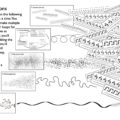Writing
My research interests include zoömusicology/biomusicology; gender and music; parenthood and creativity; music and the environment; and the cultural contexts in which music-making takes place.
Zoömusicology/Biomusicology
Emily Doolittle (2022) “Quick Guide: Birdsong and Music.” Current Biology 32, no. 20: R1064-R1066. https://doi.org/10.1016/j.cub.2022.09.018 [Contact me if you are unable to access this article.]
Emily Doolittle (2021) “‘Scarce inferior to the nightingale’: hermit thrush song and American cultural identity. Ecomusicology Review 8. [Full text here]
Emily Doolittle (2021) “Night Owls of Canada (Noctuaea canadensis)” in Becoming Feral: a book of beasts, Josh Armstrong, Alexandra Lakind, Chessa Adsit-Morris, Rebekka Sæter, eds. Objet-a Creative Studio. [Full text here, including score, performance and interview]
Luke Rendell, Emily Doolittle, Ellen Garland and Alex South (2021) “A boldly comparative approach will strengthen co-evolutionary accounts of musicality’s origins.” Brain and Behavioural Science [Available here. Please contact me if you are unable to access the article.]
Emily Doolittle (2020) “‘Hearken to the Hermit Thrush’: A Case Study in Interdisciplinary Listening.” Frontiers in Biology 11:613510. doi: 10.3389/fpsyg.2020.613510. [Full text]
Emily Doolittle and Bruno Gingras (2015) “Quick Guide: Zoomusicology.” Current Biology 24, no. 19 (2015): R819-R820. [Full text]
Emily Doolittle (2015) “Music Theory is For the Birds,” in Sound in the Land: Music and the Environment, Carol Ann Weaver, Doreen Helen Klassen, and Judith Klassen, eds. Conrad Grebel Press. [Full text]
Emily Doolittle, Bruno Gingras, Dominik M. Endres, and W. Tecumseh Fitch (2014) “Overtone-based pitch selection in hermit thrush song: Unexpected convergence with scale construction in human music.” Proceedings of the National Academy of Sciences 111, no. 46 (2014): 16616-16621. [Full text]. Media coverage of this research can be found on the Press page.
Peter Slater and Emily Doolittle (2014) “Animal Music.” Grove Dictionary of Music and Musicians.
Emily Doolittle and Henrik Brumm (2012) “O Canto do Uirapuru: Consonant intervals and patterns in the song of the musician wren.”Journal of Interdisciplinary Music Studies 6, no. 1: 55-85. [Full text] Media coverage of this research can be found on the Press page.
Emily Doolittle (2012) “Animal Sounds or Animal Songs?” The Journal of Music, http://journalofmusic.com/focus/animal-sounds-or-animal-songs. [Full text]
Emily Doolittle (2008) “Crickets in the concert hall: A history of animals in western music.” Trans. Revista Transcultural de Música 12. [Full text]
Emily Doolittle (2007) Other Species’ Counterpoint: An Investigation of the Relationship Between Human Music and Animal Songs, PhD dissertation, Princeton University.
Gender, identity, creativity, caregiving, culture
Gabriel Dharmoo, with Annette Broisin, Emily Doolittle, Anthony R. Green, Luke Nickel, Symon Henry, Teya Kasahara (2021), contributor to “Queer Perspectives in New Music,” Circuit: Musiques Contemporaines. [Abstract]
Emily Doolittle (2021) “Composer, Mother,” Routledge Handbook on Women’s Work in Music.
Emily Doolittle (2020) “On lockdown, wood pigeons, and grounding ourselves in the natural rhythms of creativity,” MacDowell Blog. [Full text]
Emily Doolittle (2020) “Art-making in a Global Pandemic,” RCS Green Room Blog. [Full text].
Emily Doolittle (2019) “How artists can benefit from having children.” The Scotsman. [Full text].
Emily Doolittle (2019) “Why Yes, I Do Want My Music Performed.” New Music Box. [Full text].
Emily Doolittle (2018) a brief introduction to the idea of “forgotten” women composers, presented as part of a roundtable discussion at the Critical Theory for Musicology Conference at University of London. [Full text].
Emily Doolittle and Neil Banas (2018) “The Long-term Effects of Gender Discriminatory Programming.” New Music Box. [Full text].
Emily Doolittle (2018) “Composing and Motherhood.” New Music Box. [Full text].
Emily Doolittle (2016) “Performing Creativity: Composing in the Era of Entrepreneurship.” VAN Magazine. [Full text].
Emily Doolittle (2016) guest post on JDCMB. “(The Lovely and) Talented“
Miscellaneous
Emily Doolittle. (upcoming 2024). A chapter about my experiences with Murray Schafer and And Wolf Shall Inherit the Moon, based on at the Murray Schafer Study Day organized by Ellen Waterman at Carleton University. [Talk]
Emily Doolittle and Angelica Mesiti, edited by Tessa Giblin and Melissa MacRobert (2022). An “in-discussion” with Angelica Mesiti, in In The Round, published by Edinburgh University Press.
Emily Doolittle. (2022) “Who I Am Today”. An online remembrance of Murray Schafer, as part of the Remembering R. Murray Schafer website edited by Kirk L. MacKenzie and Robin Elliott. [Full text]
Emily Doolittle. (2001) “Thoughts on R. Murray Schafer’s Wolf Project.” Unpublished. Please note that this paper now seems quite dated to me. However, I’m leaving this up for those interested in the history of Schafer’s work. [Full text]



